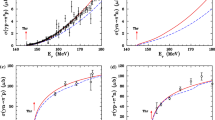Abstract
The helicity-dependent single \(\pi ^{0}\) photoproduction cross section on the deuteron and the angular dependence of the double polarisation observable E for the quasi-free single \(\pi ^0\) production off the proton and the neutron have been measured, for the first time, from the threshold region up to the photon energy 1.4 GeV. The experiment was performed at the tagged photon facility of the MAMI accelerator and used a circularly polarised photon beam and longitudinally polarised deuteron target. The reaction products were detected using the large acceptance Crystal Ball/TAPS calorimeter, which covered 97% of the full solid angle. Comparing the cross section from the deuteron with the sum of free nucleon cross sections provides a quantitative estimate of the effects of the nuclear medium on pion production. In contrast, comparison of the E helicity asymmetry data from quasi-free protons off deuterium with data from a free proton target indicates that nuclear effects do not significantly affect this observable. As a consequence, it is deduced that the helicity asymmetry E on a free neutron can be reliably extracted from measurements on a deuteron in quasi-free kinematics.






















Similar content being viewed by others
Data Availability
This manuscript has no associated data or the data will not be deposited. [Authors’ comment: The data are available from the corresponding author and will be deposited on the HEPData repository.]
References
I. Barker, A. Donnachie, Nucl. Phys. B 95, 347 (1975)
G. Keaton, R. Workman, Phys. Rev. C 53, 1434 (1996)
W.T. Chang, F. Tabakin, Phys. Rev. C 55, 2054 (1997)
Y. Wunderlich, R. Beck, L. Tiator, Phys. Rev. C 89, 055203 (2014)
Y. Wunderlich et al., Phys. Rev. C 102, 034605 (2020)
W. Briscoe et al., Eur. Phys. J. A 58, 23 (2022)
V. Tarasov et al., Phys. Rev. C 84, 035203 (2016)
V. Tarasov et al., Phys. Atom. Nucl. 79, 216 (2016)
P. Mattione et al. (CLAS Collaboration), Phys. Rev. C 96, 035204 (2017)
W.J. Briscoe et al. (A2 Collaboration at MAMI), Phys. Rev. C 100, 065205 (2019)
C. Mullen et al. (A2 Collaboration at MAMI), Eur. Phys. J. A 57, 205 (2021)
A. Kaeser et al. (A2 Collaboration at MAMI), Eur. Phys. J. A 52, 272 (2016)
M. Oberle et al., Eur. Phys. J. A 50, 54 (2014)
V. Sokhoyan et al. (A2 Collaboration at MAMI), Phys. Lett. B 802, 135243 (2020)
M. Dieterle et al. (A2 Collaboration at MAMI), Phys. Lett. B 770, 523 (2017)
E. Mornacchi, PhD thesis, University of Mainz (2021)
H. Kaiser et al., Nucl. Instrum. Methods A 593, 159 (2008)
L. Witthauer et al. (A2 Collaboration at MAMI), Eur. Phys. J. A 49, 154 (2013). arXiv:1312.1571
D. Werthmüller et al. (A2 Collaboration at MAMI), Phys. Rev. C 90, 015205 (2014). arXiv:1407.6974
L. Witthauer et al. (A2 Collaboration at MAMI), Phys. Rev. C 95, 055201 (2017)
M. Dieterle et al. (A2 Collaboration at MAMI), Phys. Rev. C 97, 065205 (2018)
J.C. McGeorge et al., Eur. Phys. J. A 37, 129 (2008)
H. Olsen, L. Maximon, Phys. Rev. 114, 887 (1959)
C. Rohlof, H. Dutz, Nucl. Instrum. Methods A 436, 430 (1999)
S. Goertz et al., Nucl. Instrum. Methods A 526, 43 (2004)
C. Bradtke et al., Nucl. Instrum. Methods A 436, 430 (1999)
L. Witthauer et al. (A2 Collaboration at MAMI), Phys. Rev. Lett. 117, 132502 (2016). arXiv:1702.01408
A. Starostin et al., Phys. Rev. C 64, 055205 (2001)
R. Novotny et al., IEEE Trans. Nucl. Sci. 38, 379 (1991)
R.A. Gabler et al., Nucl. Instrum. Methods A 346, 168 (1994)
F. Cividini, PhD thesis, University of Mainz (2020)
M. Dieterle, PhD thesis, University of Basel (2015)
S. Agostinelli et al., Nucl. Instrum. Methods A 506, 250 (2003)
M. Dieterle et al. (A2 Collaboration at MAMI), Eur. Phys. J. A 51, 142 (2015)
J. Ahrens et al., Phys. Lett. B 672, 328 (2009)
A.V. Anisovich et al., Eur. Phys. J. A 52, 284 (2016)
V. Kashevarov, L. Tiator, Private communication (2021)
H. Arenhövel, A. Fix, Phys. Rev. C 72, 064004 (2005)
A. Fix, H. Arenhövel, Phys. Rev. C 72, 064005 (2005)
A. Anisovich et al., Eur. Phys. J. A 52, 284 (2016)
Particle Data Group, P.A. Zyla et al., Prog. Theor. Exp. Phys. 2020, 035205 (2020)
M. Gottschall et al. (CBELSA/TAPS Collaboration), Phys. Rev. Lett. 100, 012003 (2014)
M. Gottschall et al. (CBELSA/TAPS Collaboration), Eur. Phys. J. A 57, 40 (2021)
Y. Wunderlich et al., Eur. Phys. J. A 53, 86 (2017)
Acknowledgements
The authors wish to acknowledge the excellent support of the accelerator group of MAMI. This work has been supported by the U.K. STFC (ST/L00478X/1, ST/T002077/1, ST/L005824/1, 57071/1, 50727/1, ST/V001035/1) grants, the Deutsche Forschungsgemeinschaft (SFB443, SFB/TR16, and SFB1044), DFG-RFBR (Grant no. 09-02-91330), Schweizerischer Nationalfonds (Contracts No. 200020-175807, No. 200020-156983, No. 132799, No. 121781, No. 117601), the U.S. Department of Energy (Offices of Science and Nuclear Physics, Awards No. DE-SC0014323, DEFG02-99-ER41110, No. DE-FG02-88ER40415, No. DEFG02-01-ER41194) and National Science Foundation (Grants NSF OISE-1358175; PHY-1039130, PHY-1714833, No. IIA-1358175), INFN (Italy), and NSERC of Canada (Grant no. FRN-SAPPJ2015-00023).
Author information
Authors and Affiliations
Consortia
Corresponding author
Additional information
Communicated by K. Peters.
Rights and permissions
About this article
Cite this article
Cividini, F., Dieterle, M., Abt, S. et al. Measurement of the helicity dependence for single \(\pi ^{0}\) photoproduction from the deuteron. Eur. Phys. J. A 58, 113 (2022). https://doi.org/10.1140/epja/s10050-022-00760-4
Received:
Accepted:
Published:
DOI: https://doi.org/10.1140/epja/s10050-022-00760-4



